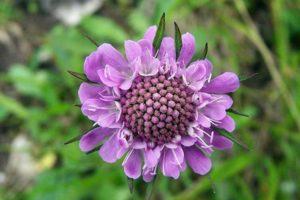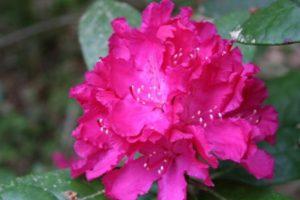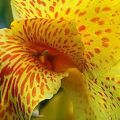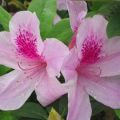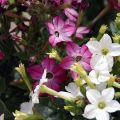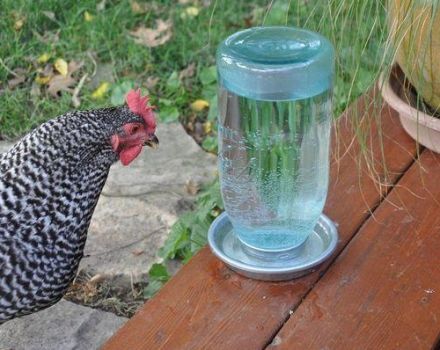26 varieties of osteospermum with a description, planting and care in the open field
Osteospermum is a perennial flower that came to the CIS countries from South Africa, planting and care is quite simple, the plant is cultivated in open soil in almost any region. The plant belongs to the group of aster flowers. Below are all the features of African chamomile that will help even novice gardeners grow it.
Content
- 1 Description and features
- 2 Osteospermum types
- 2.1 Ampelny
- 2.2 Eklona
- 2.3 Shrub
- 2.4 Conspicuous
- 2.5 Terry
- 2.6 Aquila
- 2.7 Cool
- 2.8 Bamba
- 2.9 Mix
- 2.10 Passion
- 2.11 Buttermill
- 2.12 Congo
- 2.13 Zulu
- 2.14 Volta
- 2.15 Silver sparkler
- 2.16 Cannington Roy
- 2.17 Pemba
- 2.18 Lusaka
- 2.19 Sandy Pink
- 2.20 Starry Eyes
- 2.21 Mix of colors
- 2.22 Ballad
- 2.23 Parple
- 2.24 Grand Canyon Mix
- 2.25 White
- 2.26 Sky and ice
- 3 Cultivation and care of osteospermum
- 4 Self-cultivation of osteospermum seedlings at home
- 5 Propagation by cuttings
- 6 Harmful insects and pathologies
- 7 After pollen
- 8 Tips for a Successful Osteospermum Planting
- 9 Reviews
Description and features
Osteospermum is an evergreen plant that grows up to 100 cm high. Bushes have erect stems, but there are species and creeping. The edging of the leaf blades is unevenly serrated. The flowers are similar to baskets, 5-10 cm in diameter. They are purple, pinkish, yellow, white, purple, blue or orange.
The plant differs from its relatives in that its median tubular inflorescences are sterile, and the seeds are tied with reed flowers. The culture is widely used to decorate patios, flower beds, grow in tubs and pots. Lush bloom ends only in November. Osteospermum is resistant to hot weather, dry periods, frost. In mid-latitudes, the crop is grown as an annual flower.
Osteospermum types
There are about 60 types of osteospermum. Each of them differs in flower color, size, frost resistance. Planting and care technology is the same.
Ampelny
The ampelous species is the most thermophilic of the Aster family. It needs to be covered for the winter, watered occasionally. The culture successfully takes root in pots on window sills, hanging flower beds.
Eklona
Plants have straight shoots 0.5 meters high. The inflorescences in the form of baskets grow up to 8 cm in diameter, their middle is purple-scarlet, and on the lower part there is a mass of pinkish veins.
Shrub
The variety is distinguished by creeping shoots that cover large areas. The bush grows up to 1 meter. The buds are reed, painted in a pale lilac or scarlet shade.
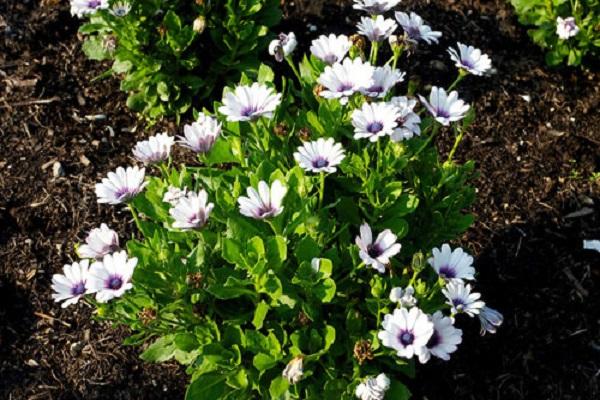
Conspicuous
The perennial blooms all year round, with reed inflorescences of a pinkish-purple tone. The color darkens towards the middle. The shrub grows up to 0.8 meters.
Terry
The variety is a well-leafy shaggy bush of emerald color. Purple buds with darkening towards the middle. The petals are corrugated, rounded towards the end, oblong.
Aquila
The Akila variety is a shrub from 41 to 51 cm. It is widely grown in pots, flower beds, ridges, as a decoration for a loggia or balcony. Inflorescences in the form of baskets, brownish-purple hue, placed on short stems. The middle is black and purple.
Cool
The variety shows resistance to frost, the bush grows up to 0.5 meters high. This is an annual bred by dimorphoteka. Panicles are white, deep purple in the middle. Stems and leaves are rich green, strong.
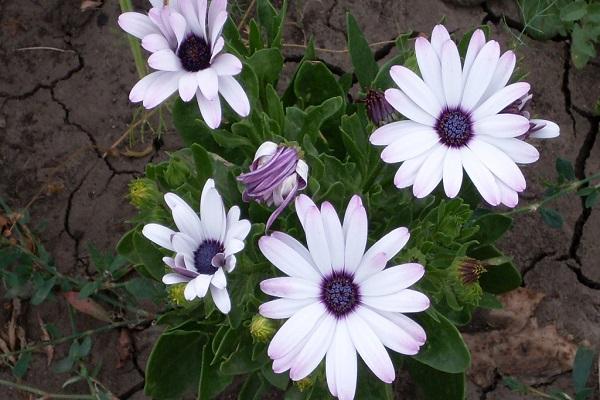
Bamba
Osteospermum Bamba is distinguished by wider inflorescences, unlike other species. When they bloom, the color is white, over time the shade changes to purple. Bushes grow up to 75 cm tall.
Mix
Osteospermum is grown as an annual plant due to climatic conditions. In warm countries, it is a perennial. Buds of various colors: lavender, pinkish, white, yellow. The bush grows compact in size, up to 0.4 meters high.
Passion
This is an annual, a low-growing bush that grows up to 45 cm. It is usually grown indoors, but you can keep the crop in vegetable gardens. Flowers of different tones: pinkish, lavender, purple and white.
Buttermill
Shrubs grow up to 0.6 meters tall. Castings are greenish-gray, and inflorescences are light yellow, darkened to the middle.

Congo
The buds of the Congo osteospermum are small, 4 cm in diameter. The flowers are purple-pinkish, and the stem and leaves are bright green. The bush grows up to 0.4 meters tall.
Zulu
This is a popular hybrid that is used to decorate home gardens. It differs from its counterparts in rich yellow flowers. The plant looks like a calendula. The height of the bush is approximately 0.5 meters.
Volta
The hybrid changes color during development. The petals are initially pinkish with a lilac tone, then turn white. The bush grows up to 1 meter tall. Leaves and stem are erect, rich green color.
Silver sparkler
The plant reaches 0.4 meters in height. The buds are white, the leaves have dots of a light shade.
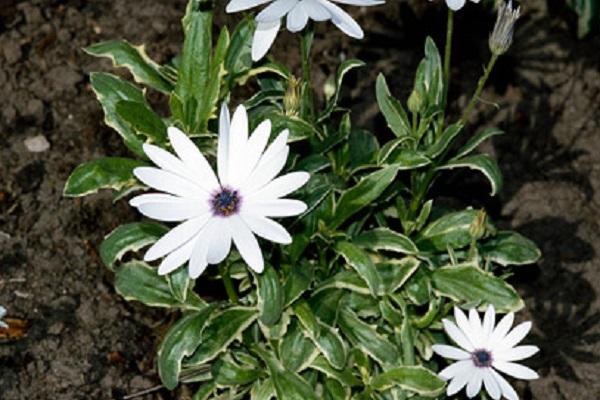
Cannington Roy
Low-growing bush creeping, emerald color. The diameter of the baskets is 8 cm, they contain white corollas, the tips of the purple color. Over time, they become purple-pinkish.
Pemba
The buds of the variety grow together in a tube to the middle, lilac color. The stem and leaves are turquoise, small. The bush grows up to 0.5 meters in height.
Lusaka
Inflorescences are ligulate, pale purple in color. The height of the shrub is about 75 cm.
Sandy Pink
The bush grows up to 0.4 meters in height. The baskets are pinkish, the shape of the petals is like a spoon.
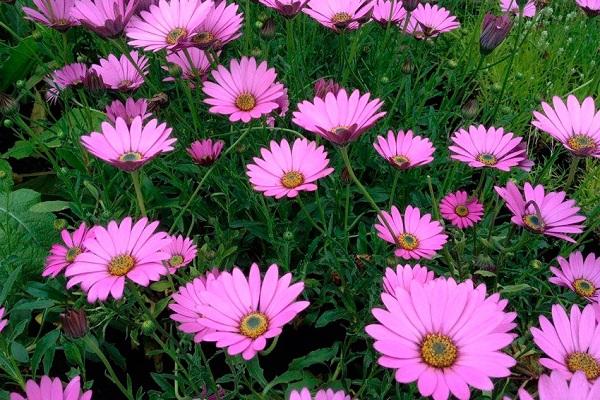
Starry Eyes
The plant reaches 50 cm in height. The lower part of the reed flowers, folded in half lengthwise, is bluish-gray. The top of the inflorescences is white.
Mix of colors
The annual variety is a bush that grows up to 25 cm in height. Inflorescences with a diameter of 5 cm, different tones: lavender, white, cream, pinkish. The leaves are glossy, deep green.
Ballad
The annual grows up to 25 in height, the bush is abundantly covered with lavender and purple flowers-baskets. Inside are orange or gray-violet centers. Leaves and stem are deep green.
Parple
This is a low-growing variety, the bush reaches 16 cm in height. Buds up to 6 cm in diameter, densely cover the plant. They are purple in color with an orange center.
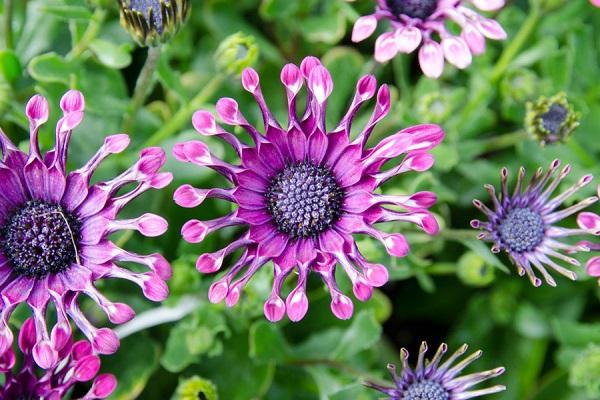
Grand Canyon Mix
The shrub grows up to 16 cm in height, covered with small inflorescences with a diameter of 6 cm. The color of the flowers is white, pinkish, lavender and light yellow.
White
The flowers are white with a dark purple tint in the middle.The height of the bush is about 30 cm, it is usually grown in pots.
Sky and ice
The plant is painted in 2 colors - white and blue, according to the name. The middle of the inflorescence is blue, with whitish petals. The height of the shrub is 75 cm, the leaves and stems are emerald green.
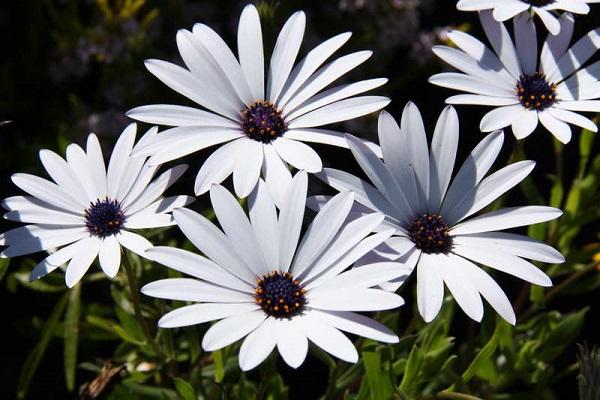
Cultivation and care of osteospermum
Osteospermum should be planted according to the scheme, observing the correct time and place.It is easy to take care of the crop, you only need timely watering, treatment from pests, fertilization, and loosening of the soil.
Seat selection
It is advisable to plant the plant in a loosened area well-lit by sunlight. In the shade, it also takes root, but the pollen will be short-lived.
Preparing the soil for osteospermum
Before planting, fertilize the soil with humus, sand and sod land. The components are taken in equal proportions. The soil should be prepared in 2-3 days.

Landing
Before planting, they dig up the soil with a depth of 30-40 cm in the flower bed, improving its structure. The soil will be saturated with oxygen, the plant will take root better.
The distance between the bushes should be 25-35 cm when planting medium varieties. Place low-growing plants at a distance of 10-15 cm from each other. Tall species of the Cool type are planted at a distance of 40-50 cm.
Seedling material is transferred with an earthen clod into holes. Sprinkle the young plants on top with potting soil. It is made from such substances: humus, sod and leafy soil, sand in equal proportions. The surface of each groove should be tamped.
Watering osteospermum
The planted seedlings should be watered abundantly immediately, 0.5 buckets of water are taken for 1 bush. Next, irrigate as the soil dries up, usually 2-3 times a week. Do not overmoisten the soil, this is fraught with rotting of the root system. Drought is also dangerous, the flower withers, and it will be impossible to revive it. Pouring water over settled, because the ice liquid stimulates the folding of the petals.
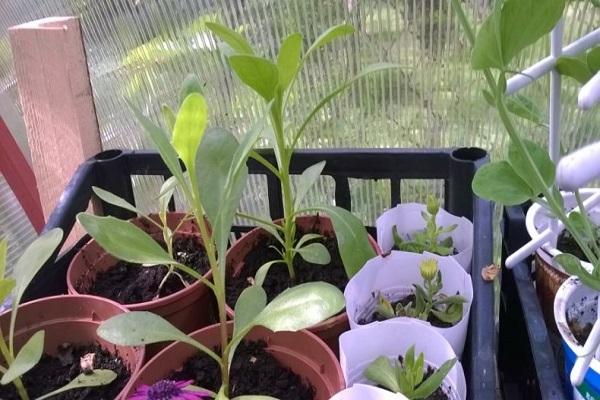
Topping
Pinch the tops to increase the density of the bush. The procedure is carried out 2-3 times during the life of the bush. Pinch off 5-7 cm of the upper stems, using a disinfected secateurs. In addition, it is important to remove wilted or dried flowers.
Self-cultivation of osteospermum seedlings at home
Seeds should be sown on seedlings in late March or early April. Peat tablets or pots filled with a combination of peat and sand are used. So that the seedlings appear faster, it is better to place them in a moistened napkin for 2-3 hours before sowing.
It is necessary to lay out one seed on a damp surface of the earth with a toothpick, deepen it 0.5 cm into the ground. They are placed in a warm place with a temperature of 20-22 degrees Celsius. The first shoots will appear in 7 days, after which they are placed in a well-lit place. If seedlings are planted in a container, they form 2-3 true leaf plates. Then a pick is carried out. When high varieties are grown, they are pinched before transplanting to obtain abundant flowering in the future.
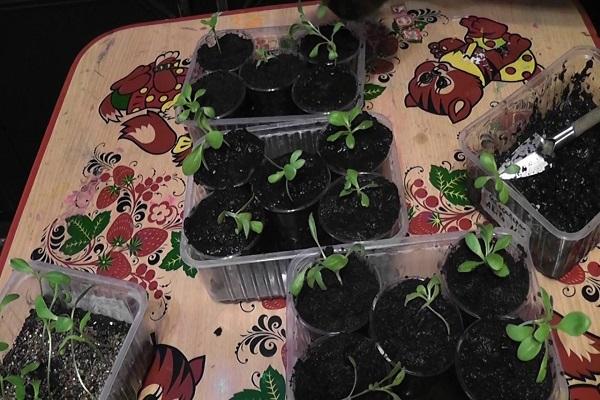
Soil preparation
The soil in the pot should be loose, moist. Experienced gardeners recommend growing seedlings in peat containers.
Hardening
It is necessary to start hardening seedlings in early May. In the room, they periodically open a window or take out seedlings to the balcony. For the first time, they should be outdoors for 15 minutes. Then the period is increased. Before planting, the seedlings are outside on daylight hours.
Timing of planting osteospermum in open ground
Seedlings are planted in a permanent place after May 25th. The air temperature should warm up to 15-20 degrees Celsius, since the plant is exotic, loves warmth.

Propagation by cuttings
Most of the varieties of osteospermum reproduce only by cuttings.This is the most reliable method to preserve all the properties of the plant.
When sowing, there is a risk of producing flowers that differ from the desired variety. Petioles are taken from the top of the bush in February. They should be rooted within 1 month. The room temperature should be +20. They are planted in pots.
If you plant the petioles in containers in the fall, and hide them indoors for the winter, they can become perennial.
Harmful insects and pathologies
The flower is famous for its high resistance to diseases and harmful beetles, but sometimes they overtake the culture. If it blooms in the shade, is watered abundantly, the immune system weakens. This entails fungal infections. The rhizome rots, the plant dries up. Affected specimens should be treated with fungicides.
Aphids still appear on the leaves, sucking the juices out of them. The plant acquires a yellow color, the leaves fall off. For the destruction of insects, they resort to Aktar, Karbofos, Aktellik.
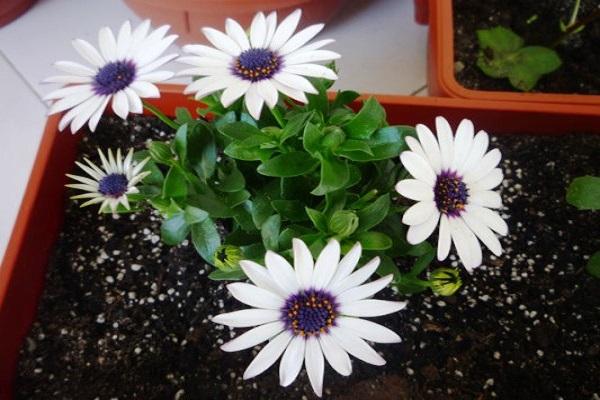
After pollen
At the onset of winter, annuals die. Perennial plants overwinter in greenhouses, premises. To preserve the bushes, they are collected in pots along with an earthen lump. When spring comes, they are planted back in the vegetable garden.
Tips for a Successful Osteospermum Planting
Experienced gardeners recommend planting osteospermum in a sunny location so that it blooms as abundantly and for as long as possible. The culture prefers well-drained, moist soil. These secrets will help grow her as blooming and healthy as possible.
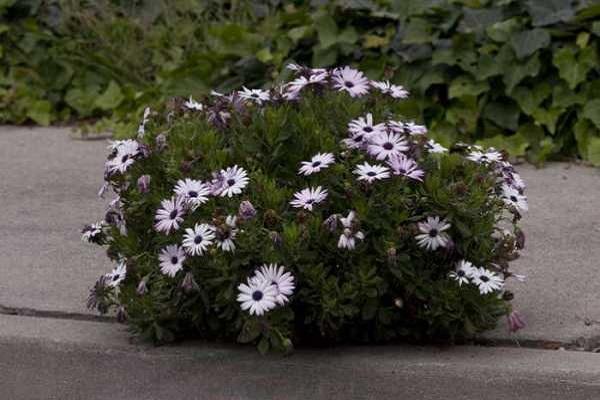
Reviews
Gardeners' responses to osteospermum are mostly positive.
Alexey Tulsky, 69 years old, Moscow
Hello! I have been planting osteospermum for more than 5 years in the garden. Preferred variety Passion and Cool. Abundant pollen, lasts until the first frost.
Victoria Ivanova, 66 years old, Dnipro
Greetings to all! A neighbor shared her seedlings of osteospermum Ballad. I grow flowers in a flower bed, they decorate the garden with purple and purple flowers until the first frost.
Maria Vakulova, 58 years old, Zaporozhye
Hello to all! Osteospermum has been grown for 4 years already, I bought seedlings on the market on the advice of the seller. Variety White grows on the windowsills of a summer residence in pots.
